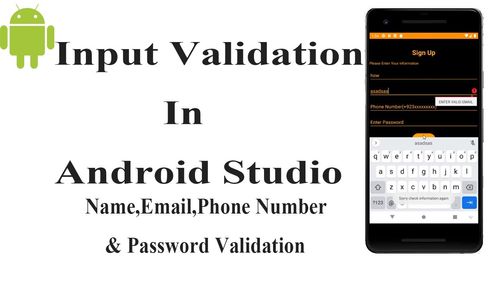In the dynamic realm of mobile app development, ensuring data accuracy is paramount. One crucial component of data accuracy is email validation, which guarantees that users enter correct and properly formatted email addresses. As a seasoned app developer, I'll be your guide through the intricacies of email validation in Android Studio, offering expert insights, real-world examples, and best practices to help you master this vital aspect of app development.
The Significance of Email Validation in Android Studio Apps
Before we dive into the technical details, it's essential to understand why email validation is so critical in Android Studio app development:
Data Accuracy: Email validation ensures that the email addresses collected from users are accurate and properly formatted, reducing errors and data inconsistencies.
User Experience: It enhances the user experience by preventing users from submitting invalid or mistyped email addresses, which can lead to frustration and errors.
Security: Proper email validation can help protect your app from spam, phishing attempts, and potentially malicious input.
Communication: Valid email addresses are essential for sending notifications, updates, and important information to users.
Implementing Email Validation in Android Studio Apps
Now, let's explore the process of implementing email validation in Android Studio apps:
1. EditText and TextWatcher:
- Utilize the
EditTextwidget to enable users to input email addresses. - Implement a
TextWatcheron theEditTextto monitor changes in the input text.
2. Regular Expression (Regex):
- Define a regex pattern that represents the valid format of an email address.
- A commonly used regex pattern for email validation in Android Studio is:
private static final String EMAIL_REGEX = "^[A-Za-z0-9+_.-]+@(.+)$";
3. Validation Logic:
- Inside the
TextWatcher, check if the entered text matches the defined regex pattern. - You can use
PatternandMatcherclasses to perform the regex matching.
4. Providing Feedback:
- If the entered email address is valid, provide visual feedback (e.g., change the color of the
EditTextborder to green). - If the email address is invalid, provide feedback (e.g., show an error message and change the border color to red).
5. Example Implementation:
Here's an example implementation of email validation in Android Studio using Java:
import android.text.Editable;
import android.text.TextWatcher;
import android.util.Patterns;
import android.widget.EditText;
public class EmailValidator {
private EditText editText;
public EmailValidator(EditText editText) {
this.editText = editText;
this.editText.addTextChangedListener(new TextWatcher() {
@Override
public void beforeTextChanged(CharSequence s, int start, int count, int after) {}
@Override
public void onTextChanged(CharSequence s, int start, int before, int count) {}
@Override
public void afterTextChanged(Editable s) {
// Validate email on text change
String email = s.toString().trim();
if (isValidEmail(email)) {
editText.setBackgroundResource(R.drawable.valid_email_background);
} else {
editText.setBackgroundResource(R.drawable.invalid_email_background);
}
}
});
}
private boolean isValidEmail(String email) {
return Patterns.EMAIL_ADDRESS.matcher(email).matches();
}
}
Handling Common Email Validation Challenges
Email validation can present some challenges, and it's essential to address them in your Android Studio app development:
1. Input Case Sensitivity:
- By default, email addresses are case-insensitive. Ensure that your validation logic is not case-sensitive.
2. Internationalization:
- Email addresses can contain non-ASCII characters in the local part or domain. Consider using libraries like
IDN.toASCII()to handle internationalization.
3. Disposable Email Addresses:
- Some users may input disposable email addresses. You can use third-party services or databases to detect disposable domains.
4. Real-time vs. Batch Validation:
- Decide whether you want to validate email addresses in real-time (on each text change) or in batches (e.g., when the user submits a form).
5. Server-side Validation:
- Always perform server-side validation to prevent malicious input and ensure data accuracy.
Common Questions About Email Validation in Android Studio
Q1. Can I use the built-in Android Patterns.EMAIL_ADDRESS constant for email validation?
A1. Yes, you can use Patterns.EMAIL_ADDRESS to perform basic email format validation. However, it doesn't cover all edge cases, so custom validation may be necessary.
Q2. What's the best way to provide feedback to users about email validation errors?
A2. You can change the appearance of the EditText field (e.g., change its border color) and display an error message near the field to inform users about validation errors.
Q3. How do I handle email validation for multiple EditText fields in a form?
A3. You can create a separate EmailValidator class for each EditText field or extend the validation logic to accommodate multiple fields in a form.
Q4. Is it necessary to perform server-side email validation in addition to client-side validation?
A4. Yes, server-side validation is crucial to prevent malicious input and ensure data accuracy. Client-side validation enhances the user experience but should not be the only line of defense.
Q5. Are there third-party libraries or APIs for email validation in Android Studio apps?
A5. Yes, several third-party libraries and APIs offer advanced email validation features and can be integrated into your Android Studio app to enhance validation capabilities.
In conclusion, email validation is a fundamental aspect of Android Studio app development, ensuring data accuracy and a seamless user experience. By following the expert insights and best practices provided in this comprehensive guide, you can implement precise email validation in your Android Studio app projects and deliver a more reliable and user-friendly product.



